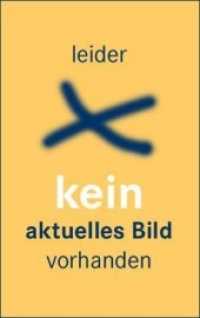- ホーム
- > 洋書
- > 英文書
- > Science / Mathematics
基本説明
This is a carefully chosen set of more than 280 structural problems employing the major modern spectroscopic techniques, a selection of 27 problems using 2D-NMR spectroscopy, more than 20 problems specifically dealing with the interpretation of spin-spin coupling in proton NMR spectra and 8 problems based on the quantitative analysis of mixtures using proton and carbon NMR spectroscopy. Previous ed.: 2008.
Full Description
The derivation of structural information from spectroscopic data is now an integral part of organic chemistry courses at all Universities. A critical part of any such course is a suitable set of problems to develop the student s understanding of how structures are determined from spectra. Organic Structures from Spectra, Fifth Edition is a carefully chosen set of more than 280 structural problems employing the major modern spectroscopic techniques, a selection of 27 problems using 2D-NMR spectroscopy, more than 20 problems specifically dealing with the interpretation of spin-spin coupling in proton NMR spectra and 8 problems based on the quantitative analysis of mixtures using proton and carbon NMR spectroscopy. All of the problems are graded to develop and consolidate the student s understanding of organic spectroscopy. The accompanying text is descriptive and only explains the underlying theory at a level which is sufficient to tackle the problems. The text includes condensed tables of characteristic spectral properties covering the frequently encountered functional groups.
The examples themselves have been selected to include all important common structural features found in organic compounds and to emphasise connectivity arguments. Many of the compounds were synthesised specifically for this purpose. There are many more easy problems, to build confidence and demonstrate basic principles, than in other collections. The fifth edition of this popular textbook: includes more than 250 new spectra and more than 25 completely new problems; now incorporates an expanded suite of new problems dealing with the analysis of 2D NMR spectra (COSY, C H Correlation spectroscopy, HMBC, NOESY and TOCSY); has been expanded and updated to reflect the new developments in NMR and to retire older techniques that are no longer in common use; provides a set of problems dealing specifically with the quantitative analysis of mixtures using NMR spectroscopy; features proton NMR spectra obtained at 200, 400 and 600 MHz and 13C NMR spectra include DEPT experiments as well as proton-coupled experiments; contains 6 problems in the style of the experimental section of a research paper and two examples of fully worked solutions.
Organic Structures from Spectra, Fifth Edition will prove invaluable for students of Chemistry, Pharmacy and Biochemistry taking a first course in Organic Chemistry. Contents Preface Introduction Ultraviolet Spectroscopy Infrared Spectroscopy Mass Spectrometry Nuclear Magnetic Resonance Spectroscopy 2DNMR Problems Index Reviews from earlier editions Your book is becoming one of the go to books for teaching structure determination here in the States. Great work! I would definitely state that this book is the most useful aid to basic organic spectroscopy teaching in existence and I would strongly recommend every instructor in this area to use it either as a source of examples or as a class textbook . Magnetic Resonance in Chemistry Over the past year I have trained many students using problems in your book - they initially find it as a task. But after doing 3-4 problems with all their brains activities...working out the rest of the problems become a mania. They get addicted to the problem solving and every time they solve a problem by themselves, their confident level also increases.
I am teaching the fundamentals of Molecular Spectroscopy and your books represent excellent sources of spectroscopic problems for students.
Contents
PREFACE vii LIST OF TABLES xi LIST OF FIGURES xiii 1 INTRODUCTION 1 1.1 GENERAL PRINCIPLES OF ABSORPTION SPECTROSCOPY 1 1.2 CHROMOPHORES 3 1.3 DEGREE OF UNSATURATION 3 1.4 CONNECTIVITY 4 1.5 SENSITIVITY 5 1.6 PRACTICAL CONSIDERATIONS 5 2 ULTRAVIOLET (UV) SPECTROSCOPY 7 2.1 BASIC INSTRUMENTATION 7 2.2 THE NATURE OF ULTRAVIOLET SPECTROSCOPY 8 2.3 QUANTITATIVE ASPECTS OF ULTRAVIOLET SPECTROSCOPY 8 2.4 CLASSIFICATION OF UV ABSORPTION BANDS 9 2.5 SPECIAL TERMS IN ULTRAVIOLET SPECTROSCOPY 10 2.6 IMPORTANT UV CHROMOPHORES 10 2.7 THE EFFECT OF SOLVENTS 14 3 INFRARED (IR) SPECTROSCOPY 15 3.1 ABSORPTION RANGE AND THE NATURE OF IR ABSORPTION 15 3.2 EXPERIMENTAL ASPECTS OF INFRARED SPECTROSCOPY 16 3.3 GENERAL FEATURES OF INFRARED SPECTRA 16 3.4 IMPORTANT IR CHROMOPHORES 17 4 MASS SPECTROMETRY 21 4.1 IONISATION PROCESSES 21 4.2 INSTRUMENTATION 23 4.3 MASS SPECTRAL DATA 24 4.4 REPRESENTATION OF FRAGMENTATION PROCESSES 29 4.5 FACTORS GOVERNING FRAGMENTATION PROCESSES 30 4.6 EXAMPLES OF COMMON TYPES OF FRAGMENTATION 30 5 NUCLEAR MAGNETIC RESONANCE (NMR) SPECTROSCOPY 34 5.1 THE PHYSICS OF NUCLEAR SPINS AND NMR INSTRUMENTS 34 5.2 CONTINUOUS WAVE (CW) NMR SPECTROSCOPY 39 5.3 FOURIER-TRANSFORM (FT) NMR SPECTROSCOPY 40 5.4 THE NUCLEAR OVERHAUSER EFFECT (NOE) 41 5.5 CHEMICAL SHIFT IN 1H NMR SPECTROSCOPY 42 5.6 SPIN-SPIN COUPLING IN 1H NMR SPECTROSCOPY 53 5.7 ANALYSIS OF 1H NMR SPECTRA 56 5.8 CHANGING THE MAGNETIC FIELD IN NMR SPECTROSCPY 58 5.9 RULES FOR SPECTRAL ANALYSIS OF FIRST ORDER SPECTRA 59 5.10 CORRELATION OF 1H 1H COUPLING CONSTANTS WITH STRUCTURE 66 6 13C NMR SPECTROSCOPY 71 6.1 COUPLING AND DECOUPLING IN 13C NMR SPECTRA 71 6.2 DETERMINING 13C SIGNAL MULTIPLICITY USING DEPT 72 6.3 SHIELDING AND CHARACTERISTIC CHEMICAL SHIFTS IN 13C NMR SPECTRA 75 7 2-DIMENSIONAL NMR SPECTROSCOPY 81 7.1 COSY (CORRELATION SPECTROSCOPY) 83 7.2 THE HSQC (HETERONUCLEAR SINGLE QUANTUM CORRELATION) OR HSC (HETERONUCLEAR SHIFT CORRELATION) SPECTRUM 84 7.3 HMBC (HETERONUCLEAR MULTIPLE BOND CORRELATION) 86 7.4 NOESY (NUCLEAR OVERHAUSER EFFECT SPECTROSCOPY) 91 7.5 TOCSY (TOTAL CORRELATION SPECTROSCOPY) 92 8 MISCELLANEOUS TOPICS 94 8.1 SOLVENTS FOR NMR SPECTROSCOPY 94 8.2 SOLVENT INDUCED SHIFTS 95 8.3 DYNAMIC PROCESSES IN NMR - THE NMR TIME-SCALE 96 8.4 THE EFFECT OF CHIRALITY 98 8.5 THE NMR SPECTRA OF "OTHER NUCLEI" 99 9 DETERMINING THE STRUCTURE OF ORGANIC COMPOUNDS FROM SPECTRA 100 9.1 SOLVING PROBLEMS 102 9.2 WORKED EXAMPLES 103 10 PROBLEMS 111 10.1 SPECTROSCOPIC IDENTIFICATION OF ORGANIC COMPOUNDS 111 10.2 THE ANALYSIS OF MIXTURES 397 10.3 PROBLEMS IN 2-DIMENSIONAL NMR 407 10.4 NMR SPECTRAL ANALYSIS 467 INDEX 493








